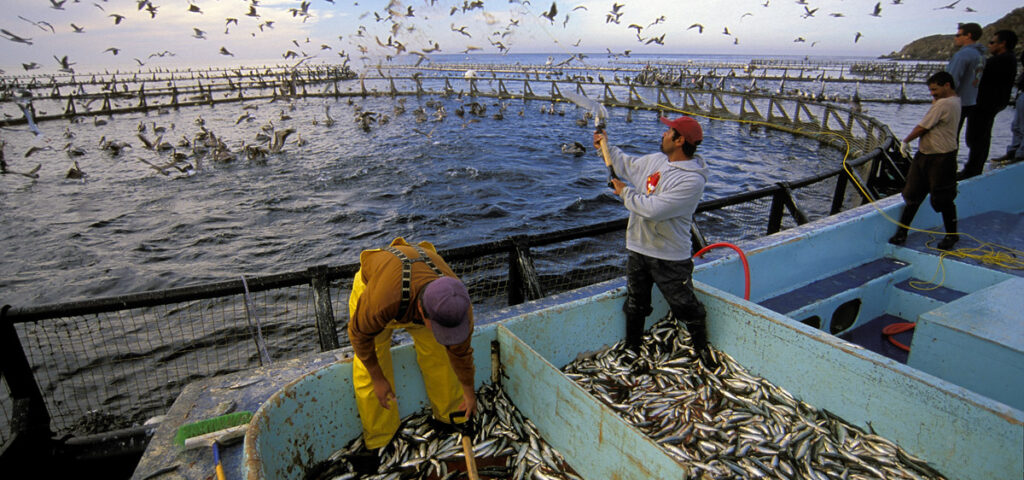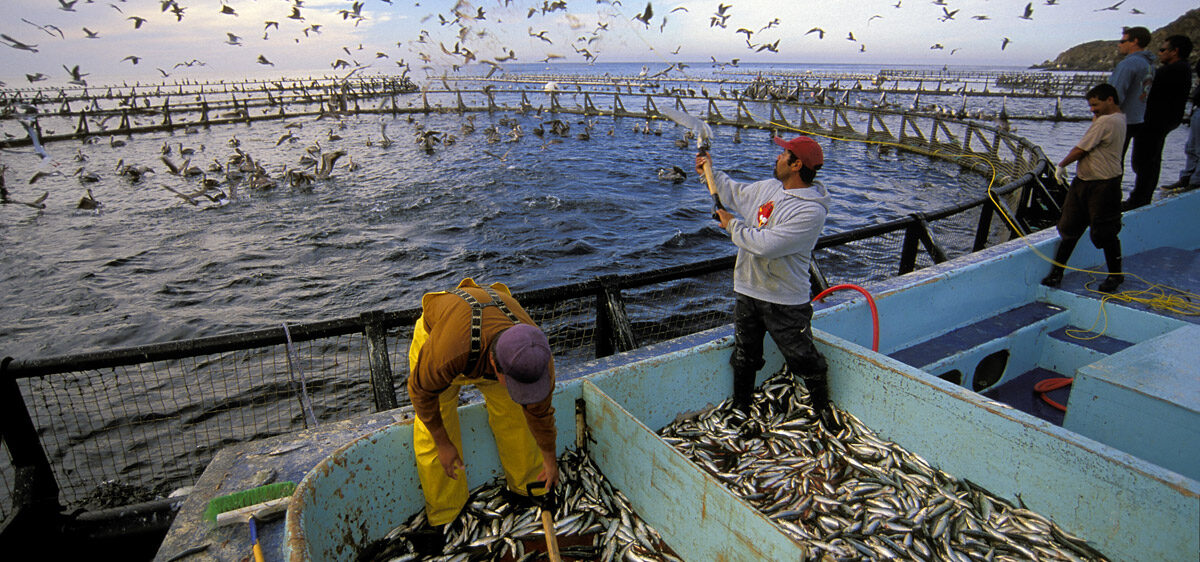Voices from the Fall 2019, Advanced Agroecology Class, at the University of Vermont (UVM)- third delivery
Every fall, for the last 10 years or so, I have been learning with the Advanced Agroecology class, at the University of Vermont (UVM). The course seeks to engage students in a diversity of learning experiences, ranging from scientific reading to farm work. One new addition this semester was to ask students to write a blog on an agroecology topic. In the next few weeks we will be sharing selected blogs from the class, providing an opportunity to glean into the bright minds and opinions of the young people that engaged with agroecology this semester. In this third contribution, Zach Merson discusses the application of agroecological principles to aquaculture. Enjoy !!
Ernesto Méndez, Professor of Agroecology and ALC Co-Director, Department of Plant and Soil Science and Environmental Program
Feed Fish to Feed Folks: Agroecological Principles in Aquaculture

I love fish: they are beautiful, they are nutritious, and they are so fun to learn from. I hold a deep interest in aquaculture, the domestication of fish for food, because of the potential to take pressure off of vulnerable ocean fisheries. However, when you read through the latest literature, most agroecological studies focus on terrestrial crops. Aquaculture is critical to the global food system because approximately 3 billion people, almost half of the world, rely on seafood as their primary source of protein, and farmed aquatic organisms contribute to nearly half of the global supply.[1] While aquaculture can reduce overfishing and habitat damage in wild fisheries, it can also be ecologically detrimental. In aquaculture farms, feed inputs and waste are often concentrated into one area of a river or coastline, degrading water quality and stimulating algae blooms. Fish populations, or stocks, are typically genetically uniform and have high rates of disease, which can spread to wild stocks. While there are groups that make recommendations on farmed seafood for consumers, I haven’t seen a clear and publicized set of principles adopted internationally for aquaculture, like agroecology has for land-based food systems.
Agroecology as a practice aims to reduce environmental damages of agriculture while enhancing social and economic vitality. International governance bodies such as the Food and Agriculture Organization of the United Nations (FAO) seek to share knowledge about and facilitate implementation of agroecological practices. The FAO’s 10 elements of agroecology are clearly targeted towards terrestrial crop and livestock systems, but I will use them as a framework to view how aquaculture can be more ecologically sustainable. Because aquaculture is still a form of farming, I believe the cultural and social elements remain unchanged between land and water, so I’m choosing to focus primarily on the FAO’s ecological elements. Specifically, I’m using the elements of diversity, efficiency, and recycling to examine contemporary challenges in aquacultural systems.

You may be familiar with diversity-enhancing practices in terrestrial agroecosystems like intercropping, cover crops, agroforestry, and crop diversification,[2] but these practices can’t be expressed in the same manner in aquaculture. Many farms on land still only incorporate a single species (think big corn fields in the Midwest) and aquaculture is no exception. Within species, especially fish, little is done to preserve genetic diversity; often millions of fish are bred from just one pair.[3] Certainly, there are technical challenges to implementing diversity in aquacultural systems that don’t apply to terrestrial crops. For example, each species often requires different infrastructure to breed, grow, and harvest, and incorrectly constructed farms are the most common causes of aquaculture failure.[4] In China, we see some systems that integrate fish, aquatic plants, and waterfowl, but there is still little diversity within each group.[5] Concentrated and genetically uniform stocks eventually suffer health and growth impacts, which reduces productivity and yield for the farmer. Reared fish can also escape, degrade the genetics of wild stocks, and spread disease.[6] Diversity is one agroecological element that is noticeably lacking in nearly every aquaculture system. I would argue that aquaculture could benefit from diversity in the same manner as terrestrial farms: improving resilience, enhancing diets, reducing ecological harms, and increasing productivity.
Efficiency refers to practices and technology that maintain or increase productivity while decreasing external inputs, such as agrochemicals.[7] I believe that recycling is a necessary and integrated component of efficient food production, and both elements in aquaculture are linked to similar challenges, so I cover FAO’s recycling element along with efficiency. Recycling is when waste or excess products are reallocated to close input and output cycles.[8] Similarly to terrestrial farms, the inputs and waste products of aquacultural systems depend on the species grown. When comparing livestock and farmed fish, feed conversion ratio (FCR) is one metric that measures the required input materials per unit product.[9] The FCR on average is 12.5 for cattle, 3 for pigs, and 1.5 for poultry.[10] Many fish have an FCR below 2 (i.e. 2 kg of feed to grow 1 kg of fish meat), and some are very close to an FCR of 1.[11] On just FCR alone, you may think “wow! Fish are such an efficient food conversion stock!” And while it’s true that fish are more efficient per kilogram of input, what the input consists of should also be an important consideration.
A lot of fish feed is made from other fish: up to 80% fish products in addition to vegetable proteins and pigments.[11] The fish that go into feed are usually those not used for human consumption. Called reduction fisheries, they include species like herring, anchovies, and menhaden. Reduction fisheries are big business because they may account for up to a sixth of captured wild fish. These fish are usually lower down in the food chain, so overfishing them can reduce the food available for important top predators like tuna.[12] In short, it’s important to be aware of what farmed fish are fed. However, there are some alternative food sources that embody the agroecological element of recycling. One company turns agricultural waste, specifically rotting or damaged fruit, into fish food that’s as nutritious as standard feed.[13] Innovative solutions and restructured cycles are what we need to turn around some of the negative impacts of farmed fish and move towards a sustainable and healthy food system. Fish do most of the efficiency work themselves through their low feed conversion ratio, so now it’s up to use to make sure we give them the best and most sustainable inputs we can.
We’ve seen that aquaculture somewhat exhibits the ecological principles of agroecology already, but also has much room for improvement. I think the Food and Agriculture Organization or another well-known agricultural group should publish an international set of principles and practices that embody ecological steward, societal wellbeing, and economic vitality in aquacultural systems. I’ve seen on working farms how agroecology aligns the farm as a landscape with the farm as a livelihood. The same revolutionary approaches can feed the fish that feed us in a healthier, more resilient, and more synchronized way with the natural world.
For more information on sustainable seafood, check out Monterey Bay Aquarium’s Seafood Watch or the Marine Stewardship Council’s Fisheries Standards.
Cited Sources
1 – http://www.fao.org/3/ca0191en/ca0191en.pdf
2 – http://www.fao.org/agroecology/knowledge/10-elements/diversity/en/
3 – https://www.ncbi.nlm.nih.gov/pmc/articles/PMC3382745/
4 – https://www.farmersweekly.co.za/animals/aquaculture/infrastructure-for-aquaculture/
5 – http://worldwideaquaculture.com/integrated-fish-farming-benefits-of-polyculture/
6 – https://www.seafoodwatch.org/ocean-issues/aquaculture/escapes
7 – http://www.fao.org/agroecology/knowledge/10-elements/efficiency/en/
8 – http://www.fao.org/agroecology/knowledge/10-elements/recycling/en/
9 – https://pdf.usaid.gov/pdf_docs/PA00K8MQ.pdf
10 – https://www.agrifarming.in/feed-conversion-ratio-formula-in-livestock
11 – http://www.fao.org/fishery/culturedspecies/Salmo_salar/en
12 – https://www.msc.org/en-us/media-center/blog/2019/09/03/are-reduction-fisheries-sustainable
13 – https://www.gainesville.com/news/20140821/gainesvilles-biotork-working-on-hawaii-expansions

